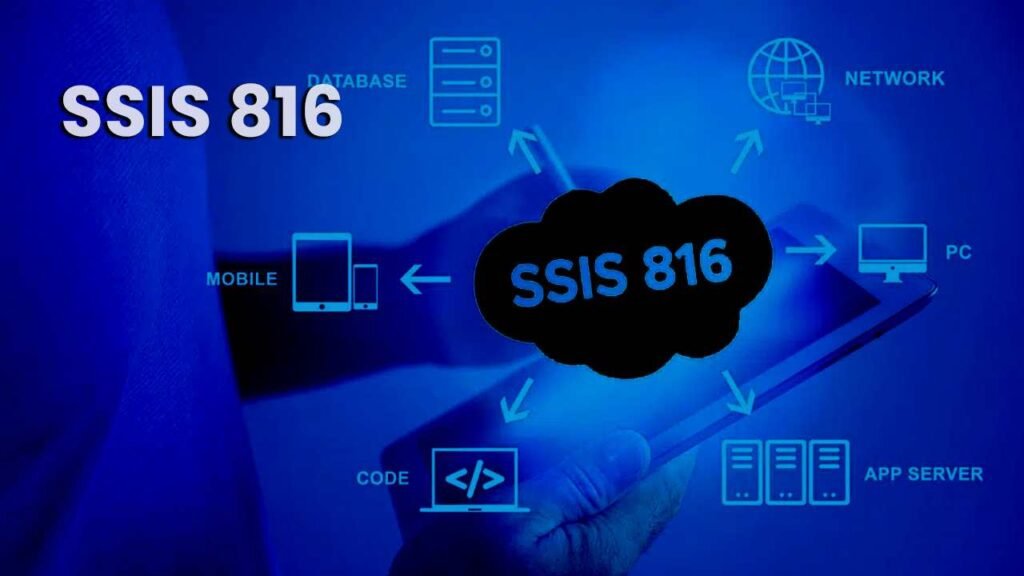Overview
In the rapidly evolving landscape of data management, SQL Server Integration Services (SSIS) 816 emerges as a game-changer, ushering in a new era of data efficiency in ETL (Extract, Transform, Load) processes. This blog post explores the key features, benefits, modifications, and practical applications of SSIS 816, emphasizing its role in enhancing scalability, performance, and cost-effectiveness in data integration.
Early Life and Evolution of SSIS
Evolution from DTS to SSIS 816
SSIS 816, a pivotal release in Microsoft’s SQL Server 2016 product family, marks a significant evolution from its predecessor, Data Transformation Services (DTS). The journey began in the early 2000s when DTS faced limitations in error handling, transformation capabilities, and scalability. Over time, SSIS evolved into a robust data integration solution, with each release addressing these limitations and introducing advanced features.

Key Features of SSIS 816
-
Distributed Execution
SSIS 816 introduces the capability to distribute the execution of packages over multiple servers. This unique feature enhances scalability and performance, allowing simultaneous processing of tasks and optimizing the execution of complex ETL operations. The distributed nature ensures faster data integration procedures, maximizing resource usage.
-
Streamlined Administration
The administration interface of SSIS 816 is centralized, simplifying the management of the entire SSIS Scale Out system. This centralized control facilitates efficient handling of scale-out ETL procedures, making system administration more structured and smooth. Troubleshooting and monitoring operations become more robust and controllable with this consolidated approach.
-
Improved Fault Tolerance
SSIS 816 improves fault tolerance by mitigating the effects of server failures, ensuring minimal disruption to the overall system. Unlike traditional single-server setups, SSIS 816 ensures that a server failure does not halt the entire ETL process. The workload distribution among servers makes the system more resilient to server problems, ensuring overall stability and minimizing disruptions.
-
Enhanced Throughput
The distributed design of SSIS 816 significantly accelerates ETL processes by allowing concurrent execution across multiple servers. This parallelized technique reduces processing times, resulting in more efficient and faster execution of data integration operations. Improved throughput is a crucial advantage for efficiently managing large datasets.
The Benefits of SSIS 816
-
Scalability Boost
SSIS 816 stands out for its remarkable scalability, particularly beneficial for businesses dealing with increasing data quantities. The tool allows for the smooth integration of additional servers, enabling organizations to handle growing workloads effectively without compromising performance.
-
Performance Optimization
By delegating application execution and leveraging parallel processing capabilities, SSIS 816 achieves remarkable performance optimization. This is especially beneficial for processes dealing with large amounts of data, as it significantly reduces the time needed for data transformations and collection from multiple sources.

-
Resource Utilization Efficiency
SSIS 816 prioritizes resource efficiency by utilizing multiple devices and eliminating the dependence on a single powerful server. This distributed computing strategy minimizes bottlenecks and increases resource efficiency across the organization, offering the same or better performance at a lower cost.
-
Cost-Effective Infrastructure
The enhanced performance of SSIS 816 contributes to making IT infrastructures more cost-effective. By forming clusters of less powerful computers instead of investing in a single expensive server, businesses can achieve optimal performance while saving costs. The distributed arrangement ensures efficient processing without compromising on performance.
-
Enhanced Parallel Processing
SSIS 816’s use of parallel processing significantly contributes to its speed and efficiency. The ability to execute tasks concurrently across multiple servers enhances the overall speed of ETL procedures, making it especially valuable for managing processes dealing with large datasets.
-
Adaptability to Growing Workloads
The adaptability of SSIS 816 becomes crucial as organizations face increasing data demands. The system’s design makes it easy to add more servers, allowing it to seamlessly adapt to changing business needs without disruptions. This adaptability is essential for achieving peak performance in dynamic corporate settings.
-
Strategic Resource Allocation
By enabling organizations to strategically manage resources based on task needs, SSIS 816 ensures the distribution of diverse jobs among several machines. This deliberate distribution of resources results in a more flexible and adaptable IT system, enhancing economic feasibility.
-
Economic Viability Through Clustered Machines
The shift towards clustered, less expensive machines enhances the economic viability of adopting SSIS 816. Instead of relying on a single high-end server, businesses can achieve the same or better performance by investing in clusters of cheaper computers. This financially wise alternative is crucial for optimizing IT spending.
Modifications and Upgrades to SSIS 816
-
Compatibility with Various SQL Server Versions
SSIS 816 is crafted for seamless compatibility with SQL Server 2016 and subsequent versions. leverage the enhanced features of SSIS Scale Out, businesses should ensure their SQL Server installations are updated to the latest compatible releases.

-
Streamlined Cluster Configuration
The configuration of a cluster of machines for collaborative work is a crucial step in setting up SSIS Scale Out. SSIS 816 enhances configuration tools and wizards, making it easier to develop an extensible ETL environment. Improved tools streamline the installation of a distributed processing system for effective data handling.
-
Enhanced Security Measures
Recognizing the importance of data security, SSIS 816 introduces security upgrades to ensure quick and secure distributed execution of SSIS software. This includes strong authentication and encryption techniques, strengthening the overall security of data.
-
Extended Support for Latest SQL Server Versions
SSIS 816 ensures seamless compatibility with future SQL Server versions and maintains support for SQL Server 2016. Staying updated with the latest compatible releases is crucial for organizations wanting to fully exploit SSIS Scale Out’s potential.
-
Improved User-Friendly Configuration
Configuring SSIS Scale Out is made easier and more intuitive in SSIS 816. Improved tools and wizards simplify the setup of a scalable ETL environment, enhancing the efficiency and controllability of the data processing system.
-
Strengthened Security Protocols
SSIS 816 prioritizes enhanced security measures. The incorporation of sophisticated authentication and encryption procedures ensures the security, privacy, and efficacy of distributed SSIS program execution.
-
Improvements and Changes
SSIS 816 provides administrators with better visibility into SSIS application performance throughout the entire cluster. Enhanced monitoring and logging capabilities allow for faster detection and resolution of problems. The dynamic scaling feature enables automatic adjustment of server involvement based on fluctuating workloads, ensuring efficient resource allocation.
Read also About
Unveiling the Enigmatic World of Geometry Spot Challenges
How to Upgrade to SSIS 816
-
Compatibility Check
Before upgrading to SSIS 816, ensure that your current SQL Server setup is compatible with the new version. SSIS 816 does not support previous versions of SQL Server, so upgrading is only possible from SQL Server 2016 or later.
-
Backup and Restore
Create a full backup of all SSIS databases and applications before initiating the upgrade. This safety step ensures a solid backup is in place to revert the system to its previous state in case of any issues during the upgrade process.
-
SSIS Scale Remove Components Installation
To upgrade, all servers in the cluster must have the SSIS Scale Out components installed. An installation wizard guides administrators through the configuration process, ensuring a smooth integration into the distributed ETL architecture.
-
Cluster Configuration
After successfully installing the components, the subsequent step involves configuring the SSIS Scale Out cluster. Establish the structure, allocate roles to servers, and configure communication channels between them. SSIS 816 simplifies this setup with user-friendly interfaces that streamline the process.
-
Testing and Validation
After configuration and upgrading, conduct a comprehensive testing procedure. Confirm results, oversee performance, and execute SSIS applications across the entire cluster. This testing phase allows for the detection and rectification of any issues before deploying SSIS 816 to a production environment.
-
Additional Considerations
Verify the compatibility of the present SSIS environment’s third-party components and custom scripts with SSIS 816. Proactively addressing compatibility issues can prevent unexpected challenges after the upgrade. Review the SSIS 816 documentation for additional considerations and best practices tailored to your organization’s use case.
By adhering to these guidelines and considering other relevant factors, organizations can ensure a seamless upgrade to SSIS 816. This reduces the risk of interruptions, allowing them to make the most of the new features and improvements.
Conclusion
In conclusion, SSIS 816 stands as a revolutionary tool in the realm of data integration and ETL processes. Its distributed execution, streamlined administration, improved fault tolerance, and enhanced throughput redefine how businesses handle large datasets. The benefits of scalability boost, performance optimization, resource utilization efficiency, and cost-effective infrastructure position SSIS 816 as a vital asset for organizations navigating the challenges of modern data environments.
The modifications and upgrades introduced in SSIS 816, including compatibility with various SQL Server versions, streamlined cluster configuration, enhanced security measures, and improved user-friendly configuration, contribute to its effectiveness and ease of use. The tool’s adaptability to growing workloads, strategic resource allocation, and economic viability through clustered machines make it a comprehensive solution for dynamic data processing needs.
The practical applications of SSIS 816 across industries highlight its versatility and importance in retail, banking, healthcare, business intelligence, and data warehousing. Whether centralizing customer information, ensuring compliance, or facilitating the propagation of electronic medical records, SSIS 816 proves invaluable for organizations seeking efficient and secure data integration.
As data professionals explore and adopt SSIS 816, they position themselves at the forefront of the evolving field of data management. Microsoft’s commitment to addressing modern data challenges is evident in the features and improvements introduced in SSIS 816, making it a thorough solution for data processing and analysis.
Frequently Asked Questions (FAQs)
What is SSIS 816?
SSIS 816 is the latest version of SQL Server Integration Services with enhanced features for data extraction, transformation, and loading (ETL).
How does SSIS 816 differ from previous versions?
SSIS 816 introduces SSIS Scale Out, allowing distributed execution for improved scalability and efficiency.
What advantages does SSIS 816 offer?
SSIS 816 provides benefits such as enhanced performance, scalability, and cost efficiency through parallel processing and resource utilization.
How does SSIS 816 streamline data workflows?
SSIS 816 streamlines workflows with user-friendly configuration and centralized package management, along with novel features like distributed execution.
Why should data professionals adopt SSIS 816?
Data professionals should adopt SSIS 816 for its optimization of data infrastructure, compliance with industry standards, and ushering in a new era of efficiency in ETL processes.





